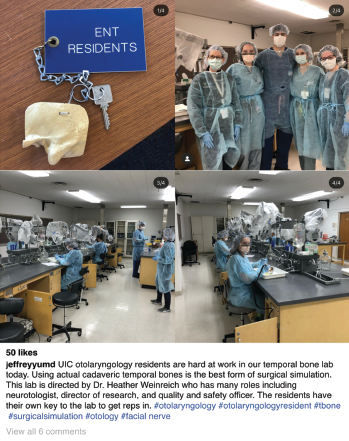Every year, medical students undergo a rite of passage by entering into the National Residency Match Program to determine their future career path, education, and living location. Medical students interested in becoming otolaryngologists are no different. The 2021 match was unique in that COVID-19 put a stop to normal activities that allowed residency programs and students to make informed and confident decisions in terms of rank lists. To provide applicants perspectives into life as a resident in these programs, academic otolaryngology departments turned to social media to provide residency information through posts and images.
Explore This Issue
January 2022Visiting student electives, conferences, and in-person interviews have all been victim to the COVID-19 cancel culture. During a visiting student elective, students and faculty have longitudinal interaction and contact to develop in-depth knowledge of each other’s attributes. The cancellation of in-person interviews and conferences prevented students from developing personal relationships that allow their unique characteristics to stand out. Zoom or online interviews allow face-to-face communication but lack subtle nuances of body language, posture, emotion, and true eye contact. As a result, both otolaryngology residency programs and prospective residency applicants were faced with a challenging task of creating rank lists because a lack of in-person experience and interaction with each other.
Turning to Instagram

Figure 1. © Courtesy John Wilson IV, MD
To increase available information to applicants, otolaryngology residency programs turned to social media, especially Instagram. As of the beginning of 2021, almost 75% of programs were participating. This smart phone-based technology allows residency programs to post a variety of pictorial content. In contrast to a static residency website that’s dependent on the frequency of updates, social media content is generated as events unfold and captures the emotion associated with the moment. The focus on candid photos and images creates and conveys ideas, values, personalities, and interpersonal interactions that are both genuine and unique.
Examples of this type of content are depicted in Figures 1 and 2. Figure 1 demonstrates the educational activity of temporal bone dissection in the department of otolaryngology at the University of Illinois at Chicago. While this post illustrates a very common educational activity and its environment, it focuses on the residents as a close-knit team, their enjoyment of the activity, and the importance of faculty participation.
I can add content and my perspective to support the messaging and values demonstrated by our resident account. By using the tagging function, my content can be amplified to reach a larger audience. —Jeffrey Yu, MD
Figure 2 is a post that introduced the PGY4 residents of the residency program at the University of Illinois at Chicago as unique individuals who are real, fun people who love otolaryngology. The focus of the post is to emphasize the value of work–life balance. Instagram has been a unique experience for both medical students and residency programs and represents an opportunity for academic otolaryngologists to enter the online world and reach out to future members of their field.
The Medical Student Perspective
The current generation of medical students already frequent Instagram to keep in touch with friends and to admire interesting people. However, current otolaryngology faculty of residency programs are from a generation that’s much less familiar with social media. Offering medical students a means to learn more about residency programs via Instagram demonstrates one generation reaching out to the future members of the field. In Dr. Curran’s experience as a medical graduate in 2021 looking for a residency, finding a residency program’s Instagram account and scrolling through its post history was often more helpful than visiting the program’s website.